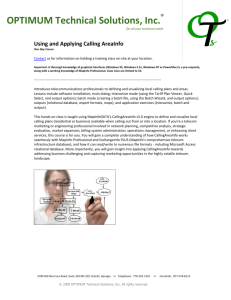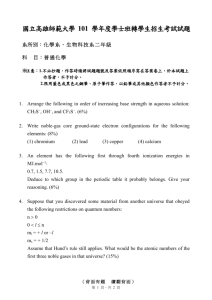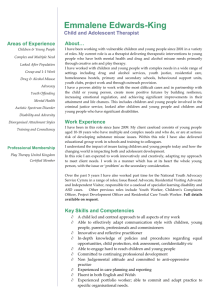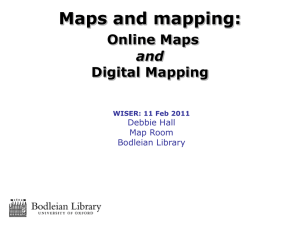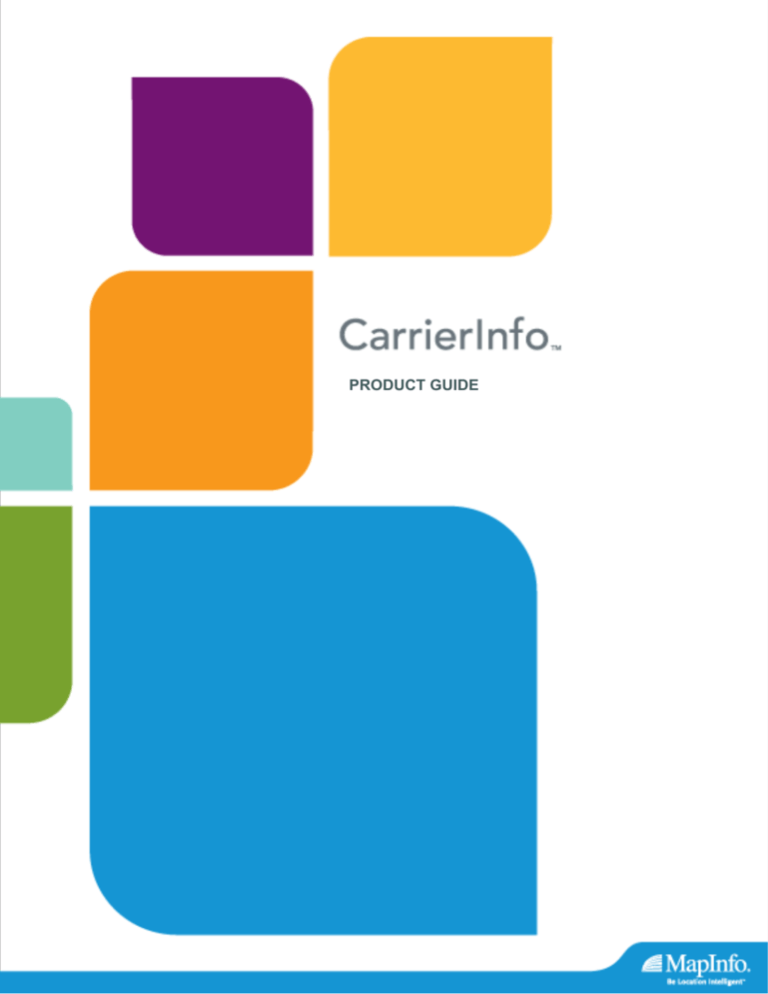
PRODUCT GUIDE
Information in this document is subject to change without notice and does not represent a commitment on the part of the vendor or its representatives. No part of this document
may be reproduced or transmitted in any form or by any means, electronic or mechanical, including photocopying, without the written permission of MapInfo Corporation,
One Global View, Troy, New York 12180-8399.
© 2005 MapInfo Corporation. All rights reserved. MapInfo, the MapInfo logo and CarrierInfo are trademarks of MapInfo Corporation and/or its affiliates.
MapInfo Corporate Headquarters:
Voice: (518) 285-6000
Fax: (518) 285-6070
Sales Info Hotline: (800) 327-8627
Government Sales Hotline: (800) 619-2333
Technical Support Hotline: (518) 285-7283
Technical Support Fax: (518) 285-6080
Contact information for all MapInfo offices is located at: http://www.mapinfo.com/contactus.
Adobe Acrobat® is a registered trademark of Adobe Systems Incorporated in the United States.
Telcordia® LERG™ Routing Guide - Special Data Product (LERG-SDP) is a trademark of Telcordia Technologies, Inc.
Products named herein may be trademarks of their respective manufacturers and are hereby recognized. Trademarked names are used editorially, to the benefit of the trademark
owner, with no intent to infringe on the trademark.
November 2005
Table of Contents
Chapter 1: Introduction . . . . . . . . . . . . . . . . . . . . . . . . . . . . . . . . . . . . . . . . . . . . . . . . . . . . 4
Overview. . . . . . . . . . . . . . . . . . . . . . . . . . . . . . . . . . . . . . . . . . . . . . . . . . . . . . . . . . . . . . . . . . . . . . 5
Background . . . . . . . . . . . . . . . . . . . . . . . . . . . . . . . . . . . . . . . . . . . . . . . . . . . . . . . . . . . . . . . . . 5
Uses . . . . . . . . . . . . . . . . . . . . . . . . . . . . . . . . . . . . . . . . . . . . . . . . . . . . . . . . . . . . . . . . . . . . . . . . . 6
Features . . . . . . . . . . . . . . . . . . . . . . . . . . . . . . . . . . . . . . . . . . . . . . . . . . . . . . . . . . . . . . . . . . . . . . 6
Installing CarrierInfo . . . . . . . . . . . . . . . . . . . . . . . . . . . . . . . . . . . . . . . . . . . . . . . . . . . . . . . . . . . . 7
Chapter 2: Detailed Data Description . . . . . . . . . . . . . . . . . . . . . . . . . . . . . . . . . . . . . . . . . 8
Coverage, Scale, and Coordinates. . . . . . . . . . . . . . . . . . . . . . . . . . . . . . . . . . . . . . . . . . . . . . . . . 9
Tables . . . . . . . . . . . . . . . . . . . . . . . . . . . . . . . . . . . . . . . . . . . . . . . . . . . . . . . . . . . . . . . . . . . . . . . . 9
Table Structures . . . . . . . . . . . . . . . . . . . . . . . . . . . . . . . . . . . . . . . . . . . . . . . . . . . . . . . . . . . . . . . 9
OCN Tables . . . . . . . . . . . . . . . . . . . . . . . . . . . . . . . . . . . . . . . . . . . . . . . . . . . . . . . . . . . . . . . . . 9
Parent Tables . . . . . . . . . . . . . . . . . . . . . . . . . . . . . . . . . . . . . . . . . . . . . . . . . . . . . . . . . . . . . . . 10
Full US Versions versus State Cut Versions. . . . . . . . . . . . . . . . . . . . . . . . . . . . . . . . . . . . . . . . 11
Compatibility with Other MapInfo Communications Data Products. . . . . . . . . . . . . . . . . . . . . 11
Chapter 3: Using CarrierInfo . . . . . . . . . . . . . . . . . . . . . . . . . . . . . . . . . . . . . . . . . . . . . . . 13
Merger and Acquisition Scenarios. . . . . . . . . . . . . . . . . . . . . . . . . . . . . . . . . . . . . . . . . . . . . . . . 14
Using CarrierInfo with Other MapInfo Communications Data Products . . . . . . . . . . . . . . . . . 15
Using CarrierInfo with RateCenterInfo . . . . . . . . . . . . . . . . . . . . . . . . . . . . . . . . . . . . . . . . . . . . 15
Using CarrierInfo with ExchangeInfo Plus . . . . . . . . . . . . . . . . . . . . . . . . . . . . . . . . . . . . . . . . . 20
Using CarrierInfo with CallingAreaInfo . . . . . . . . . . . . . . . . . . . . . . . . . . . . . . . . . . . . . . . . . . . . 25
Appendix A: Frequently Asked Questions . . . . . . . . . . . . . . . . . . . . . . . . . . . . . . . . . . . . 29
Appendix B: Glossary. . . . . . . . . . . . . . . . . . . . . . . . . . . . . . . . . . . . . . . . . . . . . . . . . . . . . 32
Acronyms . . . . . . . . . . . . . . . . . . . . . . . . . . . . . . . . . . . . . . . . . . . . . . . . . . . . . . . . . . . . . . . . . . . . 33
Terms . . . . . . . . . . . . . . . . . . . . . . . . . . . . . . . . . . . . . . . . . . . . . . . . . . . . . . . . . . . . . . . . . . . . . . . 34
Introduction
This chapter introduces MapInfo’s communications carrier data product,
CarrierInfo.
In this section…
Overview, p. 5
Uses, p. 6
Features, p. 6
Installing CarrierInfo, p. 7
1
Product Guide
Chapter 1: Introduction
Overview
CarrierInfo provides overview information about local and wireless telephone service providers.
CarrierInfo is a macro view of the communications landscape, showing the serving area region of
every telecommunications operating company. The product includes a high-level parent company view
of a carrier's service area as well as a medium-level operating company number (OCN) view of the
service area.
In particular, the product:
•
Accurately shows the service area footprints, by rate center, of U.S. communications service
providers.
•
Allows users to determine coverage areas by service type (ILEC/CLEC/Wireless), parent
company name, carrier name, or operating company number (OCN).
•
Allows users to quickly determine and compare the overall competitive landscape of various
carriers.
Background
There are three major categories of landline telecommunications carriers:
•
Regional Bell Operating Companies (RBOC)
•
Independent Telephone Companies (ICO)
•
Competitive Local Exchange Carriers (CLEC)
In addition to the landline telecommunications carriers, there are two major categories of wireless
carriers:
•
Personal Communication Services (PCS)
•
Cellular Carriers
The divestiture of AT&T in 1984 created seven RBOCs. Several of the original RBOCs have merged
and there are now four RBOCs. The local telephone companies that serve areas not served by RBOCs
are considered Independent Telephone Companies (ICO). In a given area, there is one and only one
RBOC or ICO offering service. The term “Incumbent Local Exchange Carrier” (ILEC) is used to identify
the collection of RBOCs and ICOs.
The Telecommunications Act of 1996 deregulated the telecommunications landscape and for the first
time allowed consumers to choose their local service provider. Competitive Local Exchange Carriers
(CLECs) provide alternative service in areas served by ILECs. Unlike ILECs, CLECs are not required
to provide service to all locations within their service territory, and can decline to offer service to
particular regions or consumers. Consumers in a territory in which a CLEC operates have the option to
receive local service from a CLEC rather than from the ILEC in the area. There can be multiple CLECs
offering service in a given area.
CarrierInfo
© 2005 MapInfo Corporation. All rights reserved.
5
CRI_PG_Eng.pdf
Product Guide
Chapter 1: Introduction
Uses
CarrierInfo is used to analyze telecommunications carriers’ geographic presence at a high-level.
Additionally, CarrierInfo may be used with other MapInfo data products such as ExchangeInfo Plus and
RateCenterInfo to associate parent company information with the lower-level detail provided by these
products. To see examples of how CarrierInfo can be used in conjunction with other MapInfo
communications data products, see Chapter 3: Using CarrierInfo.
For example, users can use the parent company layer to identify the footprint of Verizon
Communications through a single selection. By then adding the OCN layer from CarrierInfo, users are
then able identify all of the OCNs assigned to Verizon Communications. In this example, there are
forty-one (41) OCNs assigned to Verizon Communications. The results of this query would identify all
of the areas in which Verizon operates as an ILEC as well as a CLEC.
CarrierInfo may also be used to determine all of the CLECs that operate within a particular ILEC
service territory. A selection of the ILEC’s parent company territory can be made from the Parent
Company layer. That geographic area can then be overlaid with the CLEC layer and a selection can be
made to determine all of the CLECs that have operating territories within the ILEC footprint.
CarrierInfo is useful for a variety of different users and applications, including:
•
Mergers and Acquisitions
•
Competitive Analysis
•
Strategic expansion into new markets
The product can be used to answer questions such as:
•
How much does one company overlap other companies’ coverage area?
•
What are all the OCNs associated with Verizon or CenturyTel?
•
What are all the NPA/NXXs for a specific company?1
•
What is the parent company of an area’s ILEC/CLEC?
•
What are all the CLECs operating within a particular ILEC service area?
Features
CarrierInfo offers the following features:
•
A single source for ILEC, CLEC, and Wireless carrier service areas by rate center.
•
•
CarrierInfo allows users to identify the service areas for any communications service
provider in the United States.
Useful layers that include Parent Companies, OCNs, incumbent and competitive carriers.
•
•
The Parent company layer provides a researched parent company name so that affiliates
can be viewed as part of a larger parent company view.
The OCN layer provides a more detailed view of a parent company's serving area—in
terms of the individual operating company numbers owned by the parent company
1. This question needs data from RateCenterInfo or ExchangeInfo Plus to perform complete analysis.
CarrierInfo
© 2005 MapInfo Corporation. All rights reserved.
6
CRI_PG_Eng.pdf
Product Guide
Chapter 1: Introduction
•
Provides a critical link between Telcordia® LERG™ based company names and an industry
recognized company name.
•
Increase the value of other MapInfo communications data products such as ExchangeInfo Plus
and RateCenterInfo that rely on Telcordia LERG based company names.
Installing CarrierInfo
To install CarrierInfo, follow the steps below.
1. Do one of the following:
•
•
From the Windows Start menu, choose RUN.
From the Windows Program Manager, choose FILE > RUN.
The Run dialog box displays.
2. Type, drive:\install, where drive is the drive letter of your CD-ROM drive).
Setup.exe on the CarrierInfo CD launches the Data Installer.
3. Choose INSTALL PRODUCTS from the Installer screen.
The Welcome screen displays.
4. Click NEXT.
The License Agreement displays.
5. Read the license agreement.
6. Click YES to proceed.
The Choose Destination Location dialog box displays.
7. Do one of the following:
•
•
Click NEXT to proceed using the default destination to copy the CarrierInfo data.
Click BROWSE to select an alternative location to copy the CarrierInfo data.
The Start Copying Files dialog box displays.
8. Review the information in the Start Copying Files dialog box. Click NEXT to proceed, or click
BACK to make any changes.
CarrierInfo is now installed on your machine.
9. Click FINISH to complete the Setup and return to your desktop.
You are now ready to start using CarrierInfo.
CarrierInfo
© 2005 MapInfo Corporation. All rights reserved.
7
CRI_PG_Eng.pdf
Detailed Data Description
This chapter contains detailed information about the data included in
CarrierInfo.
In this section…
Coverage, Scale, and Coordinates, p. 9
Tables, p. 9
Table Structures, p. 9
Full US Versions versus State Cut Versions, p. 11
Compatibility with Other MapInfo Communications Data
Products, p. 11
2
Product Guide
Chapter 2: Detailed Data Description
Coverage, Scale, and Coordinates
The CarrierInfo database has the following coverage, scale, and coordinates:
•
Coverage – Continental United States, Alaska, Hawaii, and Puerto Rico
•
Scale – 1:24,000
•
Coordinates – Latitude and Longitude
•
Projection – NAD 83
Tables
Each table is a native MapInfo Professional TAB file. TAB files are composed of five component files.
Each of the component files has the same root name followed by the file extensions TAB, MAP, DAT,
IND, and ID.
The CarrierInfo database consists of the following tables:
•
RegionOcn.*
•
RegionOcnIlec.*
•
RegionOcnClec.*
•
RegionOcnWireless.*
•
RegionParent.*
•
RegionParentIlec.*
•
RegionParentClec.*
•
RegionParentWireless.*
Region is the two letter abbreviation for the covered geographic area. This is either US for the full
United States version, or the state abbreviation for individual state cuts. For example, the Ocn table for
the United States is called UsOcn.TAB, while the Pennsylvania version is called PaOcn.TAB.
Table Structures
OCN Tables
Each of the four OCN tables has the following table structure:
Column Name
Description
Type (Length)
Indexed
OCN (primary key)
Operating company number for all incumbent local
exchange carriers that have active NPA/NXXs.
Character (4)
Yes
OCN_Name
Operating company name.
Character (50)
No
CarrierInfo
© 2005 MapInfo Corporation. All rights reserved.
9
CRI_PG_Eng.pdf
Product Guide
Chapter 2: Detailed Data Description
Column Name
Description
Type (Length)
Indexed
Abbre_Ocn_Name
Abbreviated operating company name.
Character( 20)
No
ParentName
Parent company name for this OCN.
Character (100)
No
ParentID
Parent company identifier for this OCN.
Integer
Yes
Category
Category for this OCN. It has one of three values:
• ILEC
• CLEC
• Wireless
Character (10)
Yes
<object>
Combination of rate centers that have at least one active
NPA/NXX assigned to this OCN.
region
The four OCN tables contain the following information:
•
RegionOcn - Information for all operating companies.
•
RegionOcnIlec - Subset of the RegionOcn table where Category = “ILEC”.
•
RegionOcnClec - Subset of the RegionOcn table where Category = “CLEC”.
•
RegionOcnWireless - Subset of the RegionOcn table where Category = “Wireless”.
Since the ILEC, CLEC, and Wireless tables are subsets of the full RegionOcn table, all information
contained in those tables are also contained in the RegionOcn table. The information in the subset
tables is duplicated to improve usability of the product, since common analysis involves splitting the full
table by category.
Parent Tables
Each of the four Parent tables has the following table structure.
Column Name
Description
Type (Length)
Indexed
ParentID (primary key)
Parent company identifier
Integer
Yes
Category
Category for this Parent. It has one of three values:
• ILEC
• CLEC
• Wireless
Character (10)
Yes
ParentName
Parent company name.
Character (100)
No
<object>
Combination of OCNs that have this ParentID and
Category.
region
Each of the four Parent tables contain the following information:
•
RegionParent – Information for all operating companies.
•
RegionParentIlec – Subset of the RegionParent table where Category = “ILEC”
•
RegionParentClec – Subset of the RegionParent table where Category = “CLEC”
•
RegionParentWireless – Subset of the RegionParent table where Category = “Wireless”
CarrierInfo
© 2005 MapInfo Corporation. All rights reserved.
10
CRI_PG_Eng.pdf
Product Guide
Chapter 2: Detailed Data Description
Since the ILEC, CLEC, and Wireless tables are subsets of the full RegionParent table, all information
contained in those tables are also contained in the RegionParent. The information in the subset tables
is duplicated to improve usability of the product, since common analysis involves splitting the full table
by category.
The primary key for the Parent table is both ParentID and Category, since some parent companies
have operations in multiple categories. For example, Verizon Communications operates in some areas
as an ILEC and others as a CLEC, so there will be two records for Verizon Communications in the
Parent table.
About the ParentID Field
•
The ParentID is an arbitrary integer value that does not correspond to any industry-standard
code.
•
The ParentID value for a particular ParentName will not change between updates.
•
There is always a one-to-one relationship between ParentID and ParentName.
•
The OCN table may be joined to the Parent table on ParentID and Category, or on
ParentName and Category.
Full US Versions versus State Cut Versions
CarrierInfo customers who purchase data for the entire United States will receive a full US-tile version
of the product as well as the product broken up by state. The US-tile version of the product is contained
in a CarrierInfo_US folder in the installation directory. The individual state-cuts are contained in a
CarrierInfo_State folder in the installation directory.
In the US-tile version of the database, when an OCN or Parent boundary crosses state lines, the entire
region is included in one map object (which crosses state borders). The state-cut version of the
database, on the other hand, cuts each map object at the state line. So in the state-cut version, only
the portion of its coverage inside of the given state is shown when an OCN or Parent boundary crosses
state lines.
Compatibility with Other MapInfo Communications Data Products
The OCN Category values in CarrierInfo are not the same as those found in other MapInfo data
products such as CallingAreaInfo, ExchangeInfo Plus, and RateCenterInfo. The following table shows
how the CarrierInfo Category corresponds to the OCN Category values in other MapInfo data products.
Categories in other MapInfo
communications data products
CarrierInfo Category
ILEC
• RBOC
• ICO
CarrierInfo
© 2005 MapInfo Corporation. All rights reserved.
11
CRI_PG_Eng.pdf
Product Guide
Chapter 2: Detailed Data Description
Categories in other MapInfo
communications data products
CarrierInfo Category
CLEC
•
•
•
•
•
CLEC
ULEC
L RESELLER
IPES
CAP
Wireless
•
•
•
•
WIRELESS
W RESELLER
PCS
P RESELLER
CarrierInfo
© 2005 MapInfo Corporation. All rights reserved.
12
CRI_PG_Eng.pdf
Using CarrierInfo
This section describes how to use CarrierInfo in conjunction with other
communications data products to perform common queries. This section
assumes that you have a basic familiarity with MapInfo Professional
functionality. If a task is listed here that is not clear, refer to the MapInfo
Professional User’s Guide for detailed procedures on accomplishing
those particular tasks.
In this section…
Merger and Acquisition Scenarios, p. 14
Using CarrierInfo with Other MapInfo Communications Data
Products, p. 15
3
Product Guide
Chapter 3: Using CarrierInfo
Merger and Acquisition Scenarios
For users that want to look at various scenarios such as mergers and acquisitions, CarrierInfo allows
users to view the service area at the parent company level and the OCN level. As an example let us
take a look at the pending (as of November 1, 2005) MCI WorldCom and Verizon Communications
merger and what impact it will have on the service areas of Verizon Communications. The following
procedure shows how to do this.
1. Use the SQL Select dialog box to select the parent companies from the UsParent table. In this
example we are using Verizon Communications and MCI WorldCom. See the image below for
the parameters we are using.
2. Once the desired companies have been selected, create a thematic map to distinguish
between the individual company’s service areas.
Note:
It may be helpful to use a “pattern” in order to ‘see through’ the top polygon in areas of
overlapping service areas
3. Using the resulting map you can compare the difference in service areas and see how the
addition of the proposed merger or acquisition will affect the overall service area. In this
example the MCI WorldCom footprint is being added to the Verizon Communications footprint.
CarrierInfo
© 2005 MapInfo Corporation. All rights reserved.
14
CRI_PG_Eng.pdf
Product Guide
Chapter 3: Using CarrierInfo
4. In addition to visually comparing the service areas, you can incorporate the boundaries into
TargetPro to extract detailed demographic information such as population, age, and income to
better understand how the proposed coverage meets their target market. For details on
performing this additional analysis refer to the TargetPro Users Guide.
Using CarrierInfo with Other MapInfo Communications Data Products
This section highlights some common applications of CarrierInfo with other MapInfo communications
data products such as CallingAreaInfo, ExchangeInfo Plus, and RateCenterInfo. Note that licenses for
these products are required to complete the queries shown.
Using CarrierInfo with RateCenterInfo
RateCenterInfo is a map database of rate centers throughout the United States. It enables users to
accurately determine the rate centers and NPA/NXX combinations that a carrier serves and to create
maps that show all of the rate centers for a particular parent company. Using RateCenterInfo alone,
users would not know each individual OCN under which a carrier operates and would not have access
CarrierInfo
© 2005 MapInfo Corporation. All rights reserved.
15
CRI_PG_Eng.pdf
Product Guide
Chapter 3: Using CarrierInfo
to the carrier’s overall footprint. By using CarrierInfo alone, users are unable to detail the individual rate
centers and NPA/NXXs that a carrier serves. The relation between CarrierInfo and RateCenterInfo
provides the complete picture of telecommunication carriers’ footprints.
While the possibilities of using RateCenterInfo with CarrierInfo are limitless, the following examples are
some of the most common scenarios of using two products together.
Selecting the Rate Centers for a Parent Company
This scenario walks through the process of selecting the rate centers served by a particular parent
company. CarrierInfo provides the overall footprint, and RateCenterInfo provides the individual rate
centers that can be further studied for a more detailed analysis.
1. From the UsOcn table, select all the OCNs for a particular Parent Company (for example,
Sprint Communications).
2. Once the list of OCNs that the parent company operates is determined, use it to select the list
of rate centers from the Us_Rc_D table from RateCenterInfo for each OCN.
Note:
Note the use of the Group By Column parameter.
CarrierInfo
© 2005 MapInfo Corporation. All rights reserved.
16
CRI_PG_Eng.pdf
Product Guide
Chapter 3: Using CarrierInfo
3. Now that the discrete list of serving rate centers is selected, select all the rate center
geographies from the Us_Rc_G table from RateCenterInfo.
4. Finally, display the map and listing of rate centers that the particular company serves.
CarrierInfo
© 2005 MapInfo Corporation. All rights reserved.
17
CRI_PG_Eng.pdf
Product Guide
Chapter 3: Using CarrierInfo
This image only shows the first 30 records, not the entire result of the query.
CarrierInfo
© 2005 MapInfo Corporation. All rights reserved.
18
CRI_PG_Eng.pdf
Product Guide
Chapter 3: Using CarrierInfo
Selecting the NPA/NXXs a Parent Company Operates
This scenario walks through the process of identifying all the NPA/NXXs a particular parent company
operates. This information is helpful for understanding potential inventory availability of a wireless
carrier. The resulting output could be used in a lookup table or as input into additional analysis using
CallingAreaInfo (see Using CarrierInfo with CallingAreaInfo on page 25, for more details).
1. From the UsOcn table, select all the OCNs for a particular Parent Company (for example.
BellSouth Corporation).
2. Once all of the OCNs from BellSouth are selected, find all the NPA/NXXs from the Us_Rc_D
table RateCenterInfo for the selected OCNs.
3. Finally, list the results in a browser window.
CarrierInfo
© 2005 MapInfo Corporation. All rights reserved.
19
CRI_PG_Eng.pdf
Product Guide
Chapter 3: Using CarrierInfo
This image only shows the first 30 records, not the entire result of the query.
Using CarrierInfo with ExchangeInfo Plus
ExchangeInfo Plus is a map database of wire centers and Central Offices throughout the United
States. It enables users to accurately determine the NPA/NXX combinations that are included in
specific wire centers as well as carrier information. By working with both CarrierInfo and ExchangeInfo
Plus, users can quickly create maps that show all of the wire centers for a particular parent company.
By using ExchangeInfo Plus alone, users would need to know each individual OCN in order to
understand the overall carrier’s footprint as identified in CarrierInfo. By using CarrierInfo alone, users
are unable to detail the individual wire centers, Central Offices, and NPA/NXXs that a carrier serves.
Combining CarrierInfo and ExchangeInfo Plus provides the complete picture of ILECs serving areas in
the US as well as ILEC, CLEC, and Wireless Central Offices.
Selecting Wire Centers Serving an ILEC
This scenario uses data from ExchangeInfo Plus to identify the wire centers serving a particular ILEC.
1. From the UsOcnIlec table select all of the OCNs for a particular ILEC parent company (for
example, BellSouth Corporation).
CarrierInfo
© 2005 MapInfo Corporation. All rights reserved.
20
CRI_PG_Eng.pdf
Product Guide
Chapter 3: Using CarrierInfo
2. Once the list of OCNs is selected, find the list of wire centers from the UsNpaNxx table from
ExchangeInfo Plus for the selected OCNs.
3. Now that all of the CLLI codes are identified, select all the wire center geographies from the
UsWcReg table from ExchangeInfo Plus.
CarrierInfo
© 2005 MapInfo Corporation. All rights reserved.
21
CRI_PG_Eng.pdf
Product Guide
Chapter 3: Using CarrierInfo
4. Finally, display the map and listing of wire centers served by the particular ILEC.
CarrierInfo
© 2005 MapInfo Corporation. All rights reserved.
22
CRI_PG_Eng.pdf
Product Guide
Chapter 3: Using CarrierInfo
This image only shows the first 30 records, not the entire result of the query.
Selecting the NPA/NXXs Served by a Particular ILEC
This scenario walks through the process of identifying all the NPA/NXXs that a particular ILEC parent
company operates. The resulting output could be used in a lookup table or as input into additional
analysis using CallingAreaInfo (see Using CarrierInfo with CallingAreaInfo on page 25, for more
details)
1. From the UsOcnILEC table, select all the OCNs for a particular ILEC Parent Company (for
example, Verizon Communications).
CarrierInfo
© 2005 MapInfo Corporation. All rights reserved.
23
CRI_PG_Eng.pdf
Product Guide
Chapter 3: Using CarrierInfo
2. Once the list of OCNs is selected, find all the NPA/NXXs in the UsNpaNxx table from
ExchangeInfo Plus for the selected OCNs.
3. Finally, display the list using a browser window.
CarrierInfo
© 2005 MapInfo Corporation. All rights reserved.
24
CRI_PG_Eng.pdf
Product Guide
Chapter 3: Using CarrierInfo
This image only shows the first 30 records, not the entire result of the query.
Using CarrierInfo with CallingAreaInfo
CallingAreaInfo maps the local calling plans available to business and residential customers when
calling from or into a location. Calling plans are the rate structures that determine which phone
numbers can call which other phone numbers, and at what rates. Most Local Exchange Carriers
(LECs) offer more than one calling plan for each NPA/NXX combination they serve. By using
CarrierInfo and CallingAreaInfo users can determine detailed information about parent companies and
their local calling area footprints, such as what areas can call into a wireless company’s network
without incurring additional charges, or what is the overall outbound calling coverage of an ILEC.
Showing Inbound Most Restrictive Footprint For A Wireless Carrier
Users, such as Mobile Virtual Network Operators (MVNOs) are able to understand the inbound
coverage areas for wireless carriers. This information is useful in determining phone number inventory
assignments as well as actual inbound service areas for carriers for which they are partnered. This
information can also help an MVNO understand the potential of a new partner.
1. From the UsOcnWireless table, select all the OCNs for a particular wireless parent company
(for example, Sprint PCS).
CarrierInfo
© 2005 MapInfo Corporation. All rights reserved.
25
CRI_PG_Eng.pdf
Product Guide
Chapter 3: Using CarrierInfo
2. Select all the NPA/NXXs from the NpaNxx table from CallingAreaInfo for the selected OCNs.
3. Save the selection as a Microsoft Access (.mdb) table.
CarrierInfo
© 2005 MapInfo Corporation. All rights reserved.
26
CRI_PG_Eng.pdf
Product Guide
Chapter 3: Using CarrierInfo
4. Import the list of NPA/NXXs into CallingAreaInfo using the Inbound – Most Restrictive options.
5. From CallingAreaInfo create a database report and enable GENERATE MAPS.
CarrierInfo
© 2005 MapInfo Corporation. All rights reserved.
27
CRI_PG_Eng.pdf
Product Guide
Chapter 3: Using CarrierInfo
6. Display the map for the resulting coverage area. In this scenario we see the rate centers that
Sprint PCS has inventory, as well as areas that can access that inventory as a local call.
CarrierInfo
© 2005 MapInfo Corporation. All rights reserved.
28
CRI_PG_Eng.pdf
Frequently Asked Questions
Question: What is the relationship between the CarrierInfo OCN categories and the OCN category in other
products?
The OCN category values in CarrierInfo are not the same as
those found in other MapInfo data products such as
CallingAreaInfo, ExchangeInfo Plus, and RateCenterInfo. See
Compatibility with Other MapInfo Communications Data
Products in Chapter 2 on page 11, for a table that shows how
the CarrierInfo category corresponds to the OCN category values
in other MapInfo data products.
Question: What is the source for the OCN company
name and the parent company name?
The OCN Company names come directly from Telcordia LERG.
The Parent Company name is an aggregate of disparate OCN
company names, and is determined by extensive research
conducted by MapInfo to include easily recognizable names.
Question: What is the source of the geography?
The geographic boundaries in CarrierInfo are based upon
RateCenterInfo.
Question: What is the reason that the boundaries in
CarrierInfo do not line up exactly with the rate center
boundaries in RateCenterInfo or the wire center boundaries in ExchangeInfo Plus?
In an effort to reduce file size and improve performance, the node
counts in the CarrierInfo boundaries have been "thinned" to a
small extent. This results in a minor difference between the
resolution provided in ExchangeInfo Plus and RateCenterInfo.
A
Product Guide
Chapter A: Frequently Asked Questions
Question: Why do wireless coverage areas appear smaller and more fragmented than a
landline carrier in the same market?
CarrierInfo regions are built from the rate centers in which the company has phone numbers. Unlike
landline carriers, wireless carriers typically do not acquire phone numbers in every rate center they
intend to serve. Instead, they acquire phone numbers based upon the area that can call into a rate
center. The MapInfo communications data product CallingAreaInfo is used to precisely calculate the
area that can call into a rate center. See Chapter 3: Using CarrierInfo.
Question: Why are there sometimes overlaps in the ILEC layers?
Every area should have exactly one incumbent carrier, so the ILEC layers should have no holes and no
overlaps. In the few cases where this does not hold true, it is due to errors in the carrier's regulatory
filings.
Question: Why is there a separate table for Parents when the parent information is
included in the OCN table?
The region object for a parent is a combination of all OCNs with the same parent and category. The
combined view is included so that users can quickly obtain the coverage area for a parent company in
a single database row, rather than having to manually combine it themselves.
Question: What are the differences between the UsOcn table and the UsOcnIlec, UsOcnClec and UsOcnWireless tables?
The UsOcnIlec, UsOcnClec, and UsOcnWireless tables are subsets of the full UsOcn table. All
information contained in those tables are also contained in the full UsOcn table. There is no information
in the subset tables that can not be obtained from the full UsOcn table. The information in the subset
tables is duplicated to improve usability of the product, since common analysis involves splitting the full
table by category.
Question: What are the differences between the UsParent table and the UsParentIlec,
UsParentClec and UsParentWireless tables?
The UsParentIlec, UsParentClec, and UsParentWireless tables are subsets of the full UsParent table.
All information contained in those tables are also contained in the full UsParent table. The information
in the subset tables is duplicated to improve usability of the product, since common analysis involves
splitting the full table by category.
Question: Why are there multiple ParentIDs in the Parent table (why isn't the ParentID a
unique value)?
The unique key for the Parent table is ParentID and Category since some carriers have operations in
multiple categories.
Question: How is the Parent Company name defined?
The Parent Company data is an aggregate of disparate operating company names represented
through an easily recognizable industry name. This information is collected through industry research
including FCC Form 499 and carrier reports, as well as independent research of company ownerships.
Examples include:
Parent_Name
Verizon Communications
OCN
OCN_Name
0831
VERIZON NORTH INC.-IN (ALLTEL)
CarrierInfo
© 2005 MapInfo Corporation. All rights reserved.
30
CRI_PG_Eng.pdf
Product Guide
Chapter A: Frequently Asked Questions
Parent_Name
OCN
OCN_Name
Verizon Communications
4421
VERIZON CALIFORNIA INC.-NV
Verizon Communications
9104
VERIZON NEW YORK, INC.
Verizon Communications
1036
VERIZON NORTH INC.-IL (CONTEL)
Verizon Communications
2344
VERIZON WEST COAST INC.-CA
Verizon Communications
1015
VERIZON NORTH INC.-IL
TDS Telephone & Data Systems
0954
STOCKBRIDGE & SHERWOOD TELEPHONE CO.
TDS Telephone & Data Systems
0118
PORT BYRON TELEPHONE CO.
TDS Telephone & Data Systems
2377
HOME TELEPHONE CO. OR
TDS Telephone & Data Systems
1507
WINSTED TELEPHONE CO.
TDS Telephone & Data Systems
0217
AMELIA TELEPHONE CORP.
TDS Telephone & Data Systems
0958
TENNEY TELEPHONE CO.
TDS Telephone & Data Systems
0047
MERRIMACK COUNTY TELEPHONE CO.
Question: How does CarrierInfo compare to CLECInfo and LECInfo?
Previously LECInfo contained Parent Company information but lacked OCN level detail. CLECInfo
contained OCN level detail but lacked the Parent Company information. CarrierInfo combines these
two products into one commonly designed data product. This allows customers to extract the same
information from both products while introducing wireless company information as well.
Question: What OCNs are not included in CarrierInfo?
CarrierInfo includes information only for OCNs that have active NPA/NXXs. Some carriers, such as
local resellers, do not have active NPA/NXXs assigned to their OCN, and so are not included in the
product.
CarrierInfo
© 2005 MapInfo Corporation. All rights reserved.
31
CRI_PG_Eng.pdf
Glossary
This section defines acronyms and terms used throughout this manual.
In this section…
Acronyms, p. 33
Terms, p. 34
B
Product Guide
Chapter B: Glossary
Acronyms
CLEC
Competitive Local Exchange Carrier.
CLLI
Common Language Location Identifier, Wire Center Code.
CO
Central Office.
GIS
Geographic Information System.
ILEC
Incumbent Local Exchange Carriers.
LATA
Local Access Transport Area.
LEC
Local Exchange Carrier.
MVNO
Mobile Virtual Network Operator.
NPA
Numbering Plan Area, Area Code.
NXX
Prefix.
OCN
See Operating Company Number (OCN).
PCS
Personal Communications Services.
RBOC
Regional Bell Operating Company.
SQL
Structured Query Language.
CarrierInfo
© 2005 MapInfo Corporation. All rights reserved.
33
CRI_PG_Eng.pdf
Product Guide
Chapter B: Glossary
Terms
Area Code
This is another term for Numbering Plan Area or NPA. The area code is a three-digit code designating
a 'toll' center in the United States and Canada. The first three digits of a telephone number (usually
shown in parentheses) are the Area Code. For example: in the telephone number (412) 372-2399, the
Area Code is 412.
Cellular
The cellular radiotelephone service is a mobile radiotelephone service in which common carriers are
authorized to offer and provide a mobile telecommunications service for hire to the general public using
cellular systems. Cellular systems in the United States operate in the 824-894 mHz frequency bands
and have 30 kHz channel spacing.
Central Office (CO)
A telephone company facility where subscriber's lines are joined to switching equipment. This connects
subscribers to each other for local and long distance service. The CO actually delivers the dial tone to
the subscriber's phone equipment. Each CO is assigned a unique, 11-character CLLI code.
Competitive Local Exchange Carrier (CLEC)
Competitive Local Exchange Carriers provide alternate service in areas served by either an RBOC or
ILEC. CLECs are not required to provide service to all locations within their service territory, and can
decline to offer service to particular regions or consumers.
Geographic Information System (GIS)
Computer applications, such as MapInfo Professional and CallingAreaInfo, that store and manipulate
electronic maps and related data, are GIS applications.
Inbound Local Calling Area
All the NPA/NXX combinations (and associated geographic area) that can call in to a given NPA/NXX
by using a local phone service provider.
Incumbent Local Exchange Carriers (ILEC)
Incumbent Local Exchange Carriers are telephone carriers that serve areas not served by RBOCs. In a
given area there can only be one RBOC or ILEC offering service.
License Area
Geographic area (i.e., MTA, BTA, CMA, etc.) that is obtained through an FCC auction in order to
provide wireless communication at a specified frequency.
Local Access Transport Area (LATA)
The United States is divided geographically into 192 LATA regions. Local telephone companies are
permitted to offer local or long distance telecommunications services within these regions.
Local Exchange Carrier (LEC)
Local telephone companies which can either be a Regional Bell Operating Company (RBOC) or an
independent. Also referred to as ILEC.
CarrierInfo
© 2005 MapInfo Corporation. All rights reserved.
34
CRI_PG_Eng.pdf
Product Guide
Chapter B: Glossary
Mobile Virtual Network Operator (MVNO)
A company that buys network capacity from a network operator to offer its own branded mobile
subscriptions and value-added services.
Numbering Plan Area (NPA)
See Area Code.
Operating Company Number (OCN)
A number used to identify a specific telephone company.
Operating Company Number Name (OCN Name)
This is the company name as shown in the Telcordia LERG database.
Paging
A signaling and control channel which operates on a set of frequencies separate from those used to
support cellular voice communications.
Parent Company
Next level up ownership of operating OCN Name. This is an industry recognized company name that
owns/operate multiple OCNs across the country.
Personal Communications Services (PCS)
Broadband Personal Communications Services (PCS) is used to provide a variety of services, such as
digital mobile phones and wireless Internet access. These services are also called mobile telephone
services and mobile data services. PCS operates in the 1850-1990 mHz bands.
Prefix (NXX)
This term refers to the first three digits of a seven-digit local phone number.
Rate Center
Rate Centers are geographic locations laid out according to telecommunications industry standards.
The distance between two Rate Centers is used to calculate the charge rates for telecommunications
services between the two Rate Centers.
Regional Bell Operating Company (RBOC)
This is the term given to the 7 companies that were created from the initial divestiture of AT&T in 1984.
After several mergers, there are currently 4 RBOCs.
Structured Query Language (SQL)
A powerful database language you can use to pull desired information out of the CarrierInfo output
database. By using various SQL commands, you can sort through the raw output and find the kinds of
information you need for numerous applications.
Wire Center
The location where the telephone company terminates the local lines; this is usually the same location
as a Central Office. A wire center might have one or more Central Offices. Because of this, the terms
'Wire Center', 'Central Office', and 'End Office' are often used interchangeably.
Wire Center Code (CLLI)
Each Wire Center is assigned a unique, 8-character code.
CarrierInfo
© 2005 MapInfo Corporation. All rights reserved.
35
CRI_PG_Eng.pdf
Product Guide
Chapter B: Glossary
Wireless Carrier
A Cellular, PCS, or Paging company that provides wireless voice (or paging) services.
CarrierInfo
© 2005 MapInfo Corporation. All rights reserved.
36
CRI_PG_Eng.pdf


